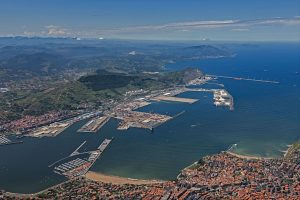Now that decarbonisation is a leading industrial goal, ports around the world are in a race towards a new competitiveness involving digitisation and energy efficiency.
This process can be illustrated through the transformation of the port of Bilbao, which has several decarbonisation and artificial vision projects underway that will change the international outlook of the main Cantabrian Sea maritime enclave.
Digitalisation and artificial vision
The digital transformation of the port of Bilbao involves the inclusion of new technologies applied to port efficiency, and the Bilbao Port Authority is therefore working on the application of the artificial vision focused on automating access control for vehicles and containers.
This has been made possible thanks to the collaboration with the startup AllRead, whose computerised vision and deep learning algorithm is able to read text, codes and symbols through images and videos taken in real time. The software recognises the vehicle type, the container code and the licence plate, as well as the dangerous goods marking.
The system also gives a new lease of life to the cameras that were already installed at the port thanks to the Telefónica network and its edge computing platform, where data is processed.
This process automation allows shortened waiting times for vehicles, increasing traceability and security of goods and is a step forward towards decarbonisation while reducing infrastructure and costs.
Decarbonisation and green energy
The Basque infrastructure is the spearhead in port environmental management to the extent of its involvement in 27 projects that are linked to the UN 2030 Agenda’s Sustainable Development Goals.
One of the most notable attempts to improve energy efficiency involves compliance with the EMAS (Eco-Management and Audit Scheme) certificate, an instrument that evaluates the environmental impact and helps to improve it in qualitative and quantitative terms. Its renewal for the sixth consecutive year is testament to the environmental improvements that have taken place at the port of Bilbao.
LED lighting and new fuels
Another relevant project involves the implementation of LED lighting along 1,300 exterior lighting points at the port. This upgrade is beneficial in economic and environmental terms, slashing more than 50% off energy costs and 66% off CO2 emissions.
Regarding energy transition, the Port of Bilbao has participated in ‘Connecting Europe Facility’, Call 2014 F02, a call aimed at achieving the decarbonisation of the Mediterranean and European Atlantic corridors.
The port of Bilbao has already been working for years in this regard and has had a wind farm capable of supplying the general network of 17,500 MWh/year since 2005. The port is currently renewing its fleet of vehicles enabling 90% of them to switch to using alternative fuels, be it electricity, LPG or hybrids
LNG also plays an important role in the energy transition plan for 2050, through projects to supply this fuel to ships in port. Worthy of mention is the natural gas tugboat already in place at the terminal that was the first of its kind in the country.
Basque Hydrogen Corridor
However, the key project that aims to turn the port into a decarbonisation hub is the Basque Hydrogen Corridor, a strategic project led by Repsol/Petronor that will be the driving force behind the entire Basque industry towards a green economy.
Numerous institutions, knowledge centres and companies are involved in the corridor, including Bilogistik, which will provide two hydrogen tractors.
The port of Bilbao is playing a key role within this consortium. In fact, the Basque Hydrogen Corridor will revolve around one of the largest plants producing synthetic fuels from the world’s green hydrogen, to be installed at the port of Bilbao.
The key feature of this type of fuel is its production with renewable energy, where water and CO2 are the only raw materials. The plant will have a capacity of 8,000 litres/day.


